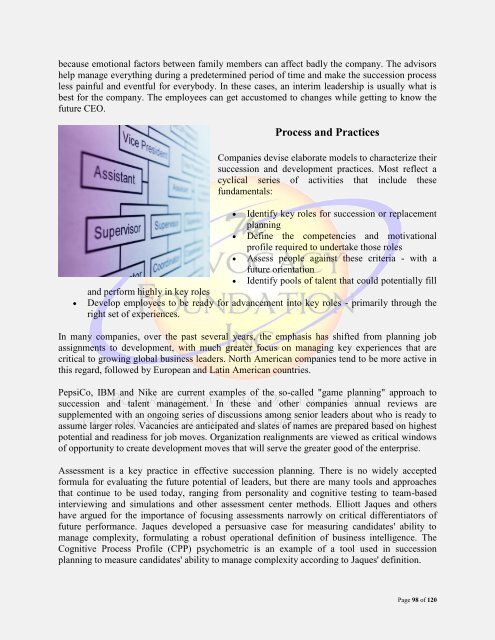Organizational Development - Vol. V, Part II
Organizational Development - Vol. V, Part II
Organizational Development - Vol. V, Part II
You also want an ePaper? Increase the reach of your titles
YUMPU automatically turns print PDFs into web optimized ePapers that Google loves.
ecause emotional factors between family members can affect badly the company. The advisors<br />
help manage everything during a predetermined period of time and make the succession process<br />
less painful and eventful for everybody. In these cases, an interim leadership is usually what is<br />
best for the company. The employees can get accustomed to changes while getting to know the<br />
future CEO.<br />
Process and Practices<br />
Companies devise elaborate models to characterize their<br />
succession and development practices. Most reflect a<br />
cyclical series of activities that include these<br />
fundamentals:<br />
<br />
Identify key roles for succession or replacement<br />
planning<br />
Define the competencies and motivational<br />
profile required to undertake those roles<br />
Assess people against these criteria - with a<br />
future orientation<br />
Identify pools of talent that could potentially fill<br />
and perform highly in key roles<br />
Develop employees to be ready for advancement into key roles - primarily through the<br />
right set of experiences.<br />
In many companies, over the past several years, the emphasis has shifted from planning job<br />
assignments to development, with much greater focus on managing key experiences that are<br />
critical to growing global business leaders. North American companies tend to be more active in<br />
this regard, followed by European and Latin American countries.<br />
PepsiCo, IBM and Nike are current examples of the so-called "game planning" approach to<br />
succession and talent management. In these and other companies annual reviews are<br />
supplemented with an ongoing series of discussions among senior leaders about who is ready to<br />
assume larger roles. Vacancies are anticipated and slates of names are prepared based on highest<br />
potential and readiness for job moves. Organization realignments are viewed as critical windows<br />
of opportunity to create development moves that will serve the greater good of the enterprise.<br />
Assessment is a key practice in effective succession planning. There is no widely accepted<br />
formula for evaluating the future potential of leaders, but there are many tools and approaches<br />
that continue to be used today, ranging from personality and cognitive testing to team-based<br />
interviewing and simulations and other assessment center methods. Elliott Jaques and others<br />
have argued for the importance of focusing assessments narrowly on critical differentiators of<br />
future performance. Jaques developed a persuasive case for measuring candidates' ability to<br />
manage complexity, formulating a robust operational definition of business intelligence. The<br />
Cognitive Process Profile (CPP) psychometric is an example of a tool used in succession<br />
planning to measure candidates' ability to manage complexity according to Jaques' definition.<br />
Page 98 of 120

















